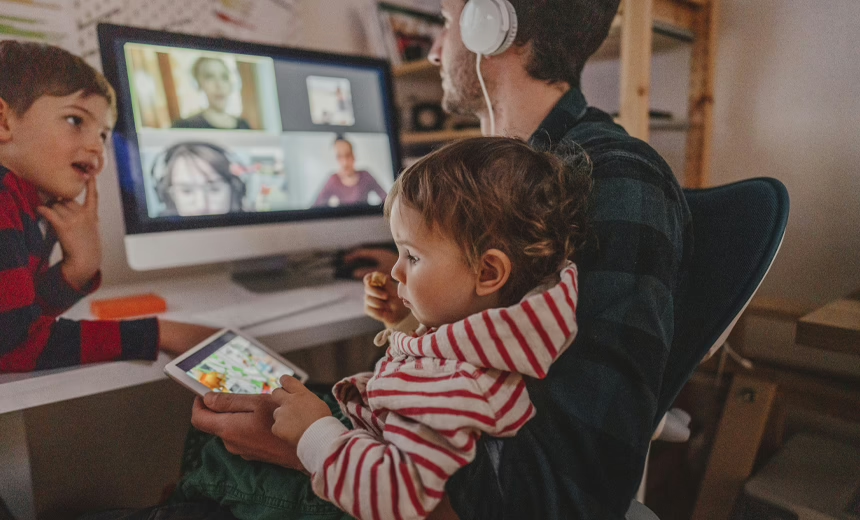Subscribe to eyeMatters periodic news
"*" indicates required fields
From the COVID-19 pandemic emerges an increase in Digital Eye Strain complaints

Are we seeing an epidemic within the pandemic?
Those of us who are fortunate enough to avoid COVID-19 may still fall victim to another growing concern – health issues linked to Digital Eye Strain, some of which may have far-reaching consequences. So, what can you do when eliminating screens is not practical for your household?
There’s no denying that screen time has skyrocketed since the start of the COVID-19 pandemic. Associate Professor Abi Tenen, a respected corneal, cataract and refractive eye surgeon based at Vision Eye Institute Melbourne, says this is translating to more people seeking help for symptoms of Digital Eye Strain.
‘We’re using digital screens for everything now,’ says A/Prof Tenen. ‘Lockdowns including Victoria’s current stage 4 restrictions have largely driven the need to go online – for school, for work, for shopping, for entertainment. The list goes on.
‘This year I am seeing a growing number of patients complaining of issues related to eye strain, with most reporting an increase in digital use of about three- to four-fold.
‘Whilst I think that we need to accept increased screen time as a given during the pandemic, it’s important to recognise some of the problems that may result and look at ways of managing them sensibly.’
What is Digital Eye Strain?
Some might refer to it as Computer Vision Syndrome, but the term Digital Eye Strain is more accurate because it’s not only computers that are the culprit.
Digital Eye Strain is not a new concept, A/Prof Tenen emphasises. ‘It has been around for years and is a well-established syndrome. Human eyes aren’t designed to stare closely at two-dimensional images for long periods.
‘Focusing on any screen – computer, laptop, tablet, phone, TV – for hours at a time can lead to various eye- and vision-related issues.
‘However, I know from personal experience that it’s not as easy as telling people to simply reduce their digital activities. Working parents who are also trying to help school their kids are struggling to find time to take breaks, often starting work early and finishing late to fit it all in.
‘Likewise, kids who are remote learning may be missing out on regimented class breaks such as recess and lunchtime as well as before- and after-school playtime.’
Symptoms of Digital Eye Strain
- Dry eyes symptoms (gritty, red, tired, itchy, sore, stinging or watery eyes)
- Feeling self-conscious about having red eyes
- Trouble wearing contact lenses
- Blurry and fluctuating vision
- Sensitivity to light and glare
- Eye fatigue
- Headaches
- Increasing short-sightedness (myopic shift)
- Trouble concentrating and sleeping (related to increased blue-light exposure)
- Mood changes and depression
As a refractive surgeon, A/prof Tenen is particularly concerned about exacerbation of dry eye and myopic changes in patients who are undergoing laser eye surgery. She is also concerned about the risk to school-aged children.
A/Prof Tenen recounts one example of a year five student who recently experienced a significant myopic shift. ‘This student went from not needing glasses at the start of this year to having a prescription of -5 D, which is an enormous shift over six months.
‘We calculated her average screen time to be eleven hours a day, with six hours of that being schoolwork. Making the situation worse was that the student loved reading and would spend additional hours with her head in books, eyes still focused on close-up objects. Her eyes weren’t getting a break.’
Treatment and prevention of eye strain
‘It’s all about returning your eyes to the three-dimensional world – every little bit of screen time reduction helps,’ says A/Prof Tenen.
Below are A/Prof Tenen’s top tips for reducing Digital Eye Strain.
TIP 1: Look away from the screen at least once every hour
- Use this time to consciously blink and apply lubricating drops
- Setting a timer can be helpful
- Make a list of quick, non-digital tasks you can do when the timer goes off (e.g. fold a load of washing, do some dishes, do some meal prep, go for a walk around the block, throw the ball to the dog, look outside the window and gaze at the clouds)
- Eat your meals away from all digital devices (even if it’s just for 5–10 minutes)
- Switch off all screens one hour (or more) before bedtime
TIP 2: Adjust your workstation
- Increase the font size on your display
- Reduce the screen brightness
- Set the blue-light filter (night shift) to turn on each evening (similarly, light your rooms with warm white globes, which disrupt our circadian rhythm less than bluer, cool white globes)
- Switch your background theme to night or dark mode
- Push your computer screen back to at least an arm’s length away
- Avoid staring at screens in dark rooms
- Use the biggest screen available (e.g. a computer over a tablet and a tablet over a phone)
‘The further from the screen the better – if you need to occupy the kids while you’ve got a Zoom meeting, seat them on the couch in front of the TV to watch their favourite show instead of giving them an iPad or phone.’
TIP 3: Swap some digital activities for analogue and/or audio ones
- Try an audiobook instead of an e-book
- Give YouTube or Netflix a miss and listen to a podcast
- Avoid doing all your exercise via online exercise classes in front of your tablet or laptop and get moving outside instead (e.g. walking, jogging, bike riding, trampolining, swimming, tennis, skipping with a rope, ball games, gardening)
- Embrace phone calls over texting and video calls – better yet, walk while you talk!
- Swap electronic games for a board game, puzzle or cards (think old school)
‘Finally, remember that this is about moderation rather than elimination,’ says A/Prof Tenen. ‘We still need to be able to enjoy some downtime with screens, but perhaps it’s only an hour or two rather than four or five hours a day.’
References
- Wong CW, Tsai A, Jonas JB et al. Digital Screen Time During the COVID-19 Pandemic: Risk for a Further Myopia Boom? Am J Ophthalmol 2020;223:333–7.
- Blehm C, Vishnu S, Khattak A et al. Computer vision syndrome: a review. Surv Ophthalmol 2005; 50(3): 253–262.
- Sheppard AL, Wolffsohn JS. Digital eye strain: prevalence, measurement and amelioration. BMJ Open Ophthalmol 2018; 3(1): e000146.
- Patil A, Bhavya, Chaudhury S et al. Eyeing computer vision syndrome: Awareness, knowledge, and its impact on sleep quality among medical students. Ind Psychiatry J 2019; 28(1): 68–74.
- Enthoven CA, Tideman JWL, Polling JR et al. The impact of computer use on myopia development in childhood: The Generation R study. Prev Med 2020; 132: 105988.
The information on this page is general in nature. All medical and surgical procedures have potential benefits and risks. Consult your ophthalmologist for specific medical advice.
Date last reviewed: 2023-11-10 | Date for next review: 2025-11-10

